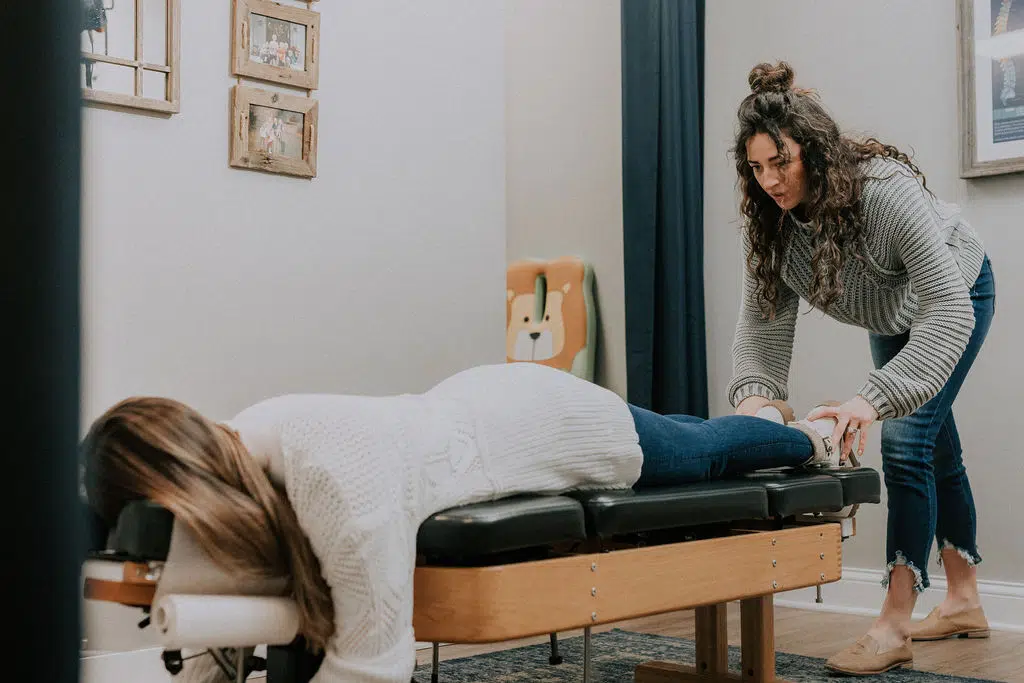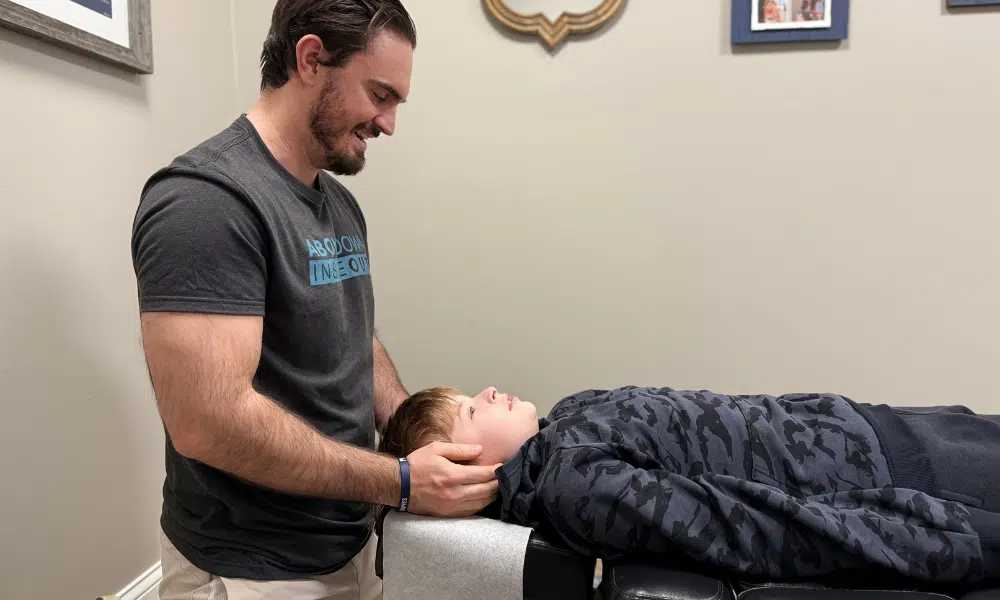As a parent, watching your teen or young adult child struggle with unexplained dizziness, fatigue, rapid heartbeat, frequent fainting, and near-constant anxiety can be terrifying and frustrating.
Every time they stand up or shift positions, you hold your breath, wondering if they’ll feel faint or need to sit back down. This is a condition that really interferes with someone’s quality of life, with symptoms flaring up often at the slightest change in temperature or position, or during stressful and busy moments when you really need your nervous system to stay regulated and balanced instead of overstressed and out of sorts.
You’ve probably been told that doctors and researchers don’t really know what causes POTS (Postural Orthostatic Tachycardia Syndrome), and that the only things you can really do to help it is learn to transition through positions more slowly, increase your salt intake, and a few other super basic things that most often do little to nothing to help the condition.
But the truth is the main cause or trigger of POTS is nervous system dysregulation and dysfunction, specifically within the Autonomic Nervous System and the nerve that helps control or regulate blood flow, blood pressure, and overall balance within the body—the vagus nerve. When nervous system dysregulation and vagus nerve dysfunction are present, it leaves the body in a state of dysautonomia, which is the foundational underlying cause of POTS and its related symptoms.
POTS is a disorder of the Autonomic Nervous System that affects an estimated 1 to 3 million Americans, primarily women. However, researchers have found the development of POTS after COVID-19 in previously healthy patients.
But what if there was a way to address the root cause of POTS and unlock your body’s natural healing potential? We’ll dive deep into what the condition really is, what causes it, and, most importantly, what you can do to reclaim your life.
What is POTS?
Postural Orthostatic Tachycardia Syndrome (POTS) is a disorder of the Autonomic Nervous System characterized by an abnormal increase in heart rate upon standing. To be diagnosed with POTS, a person must experience a heart rate increase of at least 30 beats per minute (or a rate that exceeds 120 beats per minute) within 10 minutes of standing up, in the absence of orthostatic hypotension (a drop in blood pressure upon standing).
While the diagnostic criteria focus on the abnormal heart rate response, Postural Orthostatic Tachycardia Syndrome is far more than just a fast heartbeat. People with POTS often experience a wide range of signs that can vary in severity from person to person. These POTS symptoms may include:
- Dizziness or lightheadedness upon standing
- Fatigue and weakness
- Brain fog and difficulty concentrating
- Headaches
- Heart palpitations
- Tremors or shaking
- Shortness of breath
- Chest pain
- Nausea and digestive issues
- Blurred vision or tunnel vision
- Sleep disturbances
For some, these POTS symptoms may be mild and only occasionally disruptive. But for others, they can be severely debilitating, making it difficult to perform even basic daily tasks like bathing, eating, or standing for short periods.
Research has shown that the quality of life in POTS patients is often comparable to that of people living with chronic illnesses like kidney disease on dialysis.
The impact of POTS extends beyond physical symptoms. Many people with POTS report feeling anxious, depressed, or hopeless due to the limitations imposed by their condition. They may struggle to maintain relationships, pursue education or career goals, or participate in social activities that healthy individuals take for granted.
Subtypes of POTS Syndrome
Despite the substantial impact that Postural Orthostatic Tachycardia Syndrome can have on a person’s life, it is still a poorly understood and frequently misdiagnosed condition. Many medical professionals lack familiarity with it, resulting in delays in diagnosis and care. Patients often find that their POTS symptoms are dismissed as merely being “all in their head,” or they may be inaccurately told that they are simply out of shape or overly anxious.
It’s important for patients and parents to know that there are a few different subtypes of POTS Syndrome:
Neuropathic POTS
Neuropathic POTS, a specific subtype of POTS syndrome, is closely associated with dysfunction in the autonomic nerves that regulate heart rate and blood vessel constriction. One crucial nerve involved in autonomic control is the Vagus Nerve.
Neuropathic POTS is the most common subtype, and up to 50% of patients with the condition have restricted autonomic dysfunction.
When the Vagus Nerve experiences damage or dysfunction, known as subluxation, it can disrupt the delicate balance of the Autonomic Nervous System, leading to symptoms commonly seen in POTS, such as tachycardia, lightheadedness, and postural blood pressure fluctuations.
The Vagus Nerve plays a vital role in regulating various bodily functions, including heart rate, digestion, and blood pressure. Dysfunction of the vagus nerve can disrupt the communication between the brain and the body, leading to dysautonomia—a condition characterized by an impaired Autonomic Nervous System.
Dysautonomia can manifest in different ways, such as orthostatic hypotension (a drop in blood pressure upon standing), gastrointestinal issues, temperature regulation problems, and sleep disturbances, as well as behavioral or emotional dysregulation. Understanding the connection between Neuropathic POTS and Vagus Nerve Dysfunction is essential in developing targeted care options that address the underlying nerve dysfunction, promote relief for individuals with POTS syndrome, and help restore their quality of life in a significant way.
Hyperadrenergic POTS
Hyperadrenergic POTS is another variant, typically associated with an excess release of norepinephrine, a stress hormone. This type of POTS often manifests with symptoms such as palpitations, anxiety, and elevated blood pressure.
Since the adrenal glands primarily respond to stimulation and activation of the Sympathetic Nervous System, this subtype of POTS Syndrome can often be traced back to the Neuropathic Type and Dysautonomia.
A few other subtypes include:
- Hypovolemic POTS: Hypovolemic POTS occurs when there is a decrease in blood volume within the body. This can result from factors such as dehydration, blood loss, or certain medical conditions. Symptoms may include fainting, rapid pulse, and difficulty concentrating.
- Secondary POTS: Secondary POTS develops as a result of another underlying condition, such as Ehlers-Danlos syndrome or autoimmune conditions. Identifying and caring for the primary condition is crucial in managing secondary POTS effectively.
What Causes POTS?
To fully grasp what’s happening in POTS, it’s essential to understand the Autonomic Nervous System (ANS) and its vital role in maintaining balance within the body. The ANS is responsible for controlling all of our involuntary functions, such as heart rate, blood pressure, digestion, and temperature regulation—essentially, all the things we don’t have to consciously think about.
The ANS is divided into two main branches:
- The Sympathetic Nervous System (SNS): Often referred to as the “fight or flight” response, the SNS activates when we perceive a threat or stressor. It increases heart rate, blood pressure, and blood flow to the muscles, preparing the body for action.
- The Parasympathetic Nervous System (PNS): Known as the “rest and regulate” response, the PNS helps the body conserve energy and recover after periods of stress. It slows heart rate, promotes digestion, and facilitates a state of relaxation.
In a healthy individual, the sympathetic and parasympathetic branches work together seamlessly to maintain homeostasis—a state of optimal balance and function. When we stand up, for example, the ANS quickly adjusts blood flow and heart rate to ensure enough blood reaches the brain, preventing dizziness or fainting.
However, in people with POTS, this delicate balance is disrupted. The ANS fails to properly regulate heart rate and blood pressure upon standing, leading to an excessive increase in heart rate and a range of associated symptoms. This imbalance between the sympathetic and parasympathetic branches is known as dysautonomia.
One of the key players in the Autonomic Nervous System is the vagus nerve. This long, wandering nerve extends from the brainstem to the abdomen, connecting the brain to many vital organs along the way. It plays a crucial role in regulating heart rate, digestion, and inflammation, among other essential functions.
In POTS, the vagus nerve may be underactive or dysfunctional, contributing to the hallmark symptoms of the condition. When the vagus nerve isn’t working properly, it can’t effectively counterbalance the Sympathetic Nervous System’s “fight or flight” response, leading to a state of chronic nervous system overactivation.
This imbalance can manifest in various ways, from the classic tachycardia and dizziness upon standing to digestive issues, fatigue, anxiety, and more.
The “Perfect Storm” of Dysautonomia and Vagus Nerve Dysfunction
While POTS can be triggered by a variety of factors, the true underlying root cause is dysautonomia—an imbalance in the Autonomic Nervous System. This dysautonomia often develops as a result of what we call The “Perfect Storm”—a combination of stressors that accumulate over time to overwhelm the delicate balance of the nervous system.
At the heart of this “Perfect Storm” is vagus nerve dysfunction. The vagus nerve is a critical component of the parasympathetic “rest and regulate” branch of the Autonomic Nervous System. When functioning properly, it helps to counterbalance the sympathetic “fight or flight” response, promoting relaxation, digestion, and recovery.
However, a range of factors can disrupt the vagus nerve’s function, setting the stage for dysautonomia and POTS:
- Birth trauma and interventions: Physical strain during delivery from forceps, vacuum extraction, or c-section can cause subtle misalignments and tension in the upper neck and brainstem area where the vagus nerve originates. This can impair vagal tone and regulation from an early age.
- Viruses and infections: Conditions like mononucleosis, Lyme disease, and even COVID-19 can directly inflame and damage the vagus nerve, disrupting its ability to properly regulate the Autonomic Nervous System.
- Autoimmune conditions: Conditions like Ehlers-Danlos syndrome (EDS) and Mast Cell Activation Syndrome (MCAS) are associated with increased autoimmunity and inflammation, which can target and impair the vagus nerve.
- Prolonged stress and trauma: Chronic mental and emotional stress, particularly early in life, can lead to a state of constant sympathetic “fight or flight” activation. Over time, this can essentially “burn out” the vagus nerve and parasympathetic system, leading to dysautonomia.
- Poor posture and text neck: While it may sound too simple, the constant physical strain and tension placed upon the delicate blood vessels, vagus nerve, and other crucial nerves that run along the neck from chronic poor posture and text neck is enough to disrupt and exhaust these functions and lead to subluxation, dysregulation, and dysautonomia. This is why the restoration of posture and neurospinal function must be the foundation of POTS care programs, not just working on salt and fluid intake.
When the vagus nerve is dysfunctional, the Autonomic Nervous System gets stuck in a state of sympathetic overdrive. The “rest and regulate” functions are impaired, leading to hallmark POTS symptoms like tachycardia, dizziness, digestive distress, and more.
This understanding of vagus nerve dysfunction and dysautonomia as the true root causes of POTS is central to PX Docs’ approach.
PX Docs’ Approach to POTS
At PX Docs, we take a unique approach to caring for POTS that differs from the conventional medical model. Rather than simply managing symptoms with medications or alterations in movement patterns, salt intake, and so forth – our goal is to identify and address the underlying causes of dysautonomia and vagus nerve dysfunction, activating and stimulating the body’s own natural healing mechanisms and working to restore it to balance and homeostasis.
One of the key tools we use to guide our care is the INSiGHT scanning technology. These advanced scans allow us to objectively measure nervous system function, pinpointing areas of dysregulation or dysfunction that may be contributing to POTS symptoms. By tracking changes in these scans over time, we can tailor our care plans to each individual’s unique needs and monitor progress.
Along with chiropractic care, we also emphasize the importance of complementary lifestyle interventions. Increasing fluid and electrolyte intake, staying active and physically fit (especially working on postural stability), practicing good sleep habits, and making sure to have a clean, healthy diet focused on plenty of good protein and healthy fats.
A Real Success Story
Our patient, Tommi, went from being a wildly active and athletic high school student to barely being able to get through the basic functions of everyday life. Here’s what her mom wrote on the intake paperwork, truly describing the many struggles patients with POTS Syndrome experience each day.
“The symptoms that she has been experiencing are associated with her POTS diagnosis, which has completely derailed her 17-year-old life. The massive fatigue that she experiences keeps her in bed all day long, and the migraine headaches and brain fog that have made it impossible for her to do any schoolwork for the last 4 weeks.
She has also been experiencing each of the following to varying degrees: lightheadedness and dizziness upon standing (sometimes upon sitting upright); tachycardia; low blood pressure; high heart rate; nausea and stomach pain; chest pain; neck pain; blurry vision; getting really hot and/or really cold; insomnia; anxiety and depression.
The brain fog is so very troubling to me; it is almost as if she cannot form the thoughts needed to bring her from point A to point B to point C. She was an A-B student before this all started, and now just trying to decide which homework subject to work on totally shuts her down.”
As you can see from Tommi’s INSiGHT Scans below, she had the exact location and pattern of subluxation, dysfunction, and dysautonomia we often see in patients with POTS:
- First, she had significant tension, sympathetic dominance, and subluxation throughout her cervical and upper thoracic neurospinal regions, namely C5, T2, and T4 (indicated by red bars on EMG) – leading to not only the excessive sympathetic tone and response, but also disrupting vagal nerve signaling and tone.
- Second, her HRV indicates overall dysautonomia and autonomic nervous system “fatigue” or “exhaustion” as indicated by the white dot on the graph below the green box, and her Autonomic Activity Index only being 71.64 when it should easily be 85+ for an active teenager.
- Third, her NeuroThermal scan indicates significant neuro-adrenal fatigue and inefficiency as evidenced by the subluxation and interference present at T9 + T10 (and a bit lower) on that scan.
As Tommi went through her Intensive Program of neurologically-focused chiropractic adjustments and continued care back home with her local PX Doc, she noticed drastic improvements in her energy, stability, sleep, posture, and so much more! She started to get back to the things she loves like school, riding horses, and being active – and now Tommi is headed off to college with a scholarship and planning to become a nervous system chiro herself and help other kids and patients struggling like she was!
Charting a Path to Healing
Living with POTS can be like having a phone with a worn out battery. Sometimes it’s fully charged and works great, and other times it stops working without warning and won’t hold a charge no matter what. The physical, emotional, and social toll of this complex condition cannot be overstated. But as we’ve explored in this article, there is reason for hope and excitement once you find the real root cause – nervous system dysregulation and dysfunction!
By understanding the complexities of the Autonomic Nervous System, the Vagus Nerve, and the factors that can lead to their dysfunction, we can get to the real root cause of POTS, and develop targeted, effective strategies to help restore balance and function to the nervous system and vagus nerve.
PX Docs’ Neurologically-Focused approach, grounded in cutting-edge research and technology, offers a promising path forward for many patients and families.
If you or a loved one is struggling with POTS, we invite you to explore the resources and expertise available through PX Docs. Our directory can help you find a qualified practitioner in your area who can partner with you to create a personalized care plan and support you every step of the way.
Remember, you are not defined by your diagnosis. With the right tools, perspective, and support, it is possible to weather the storm of POTS and emerge stronger, more resilient, and more connected to your own inherent healing potential than ever before!





